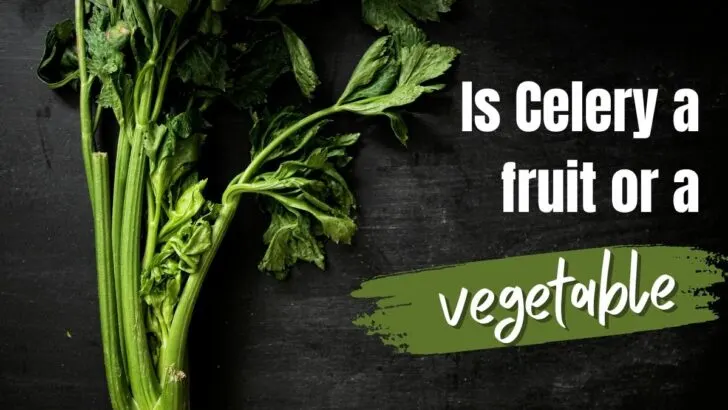Celery is a popular plant that is not only refreshing and crunchy, but also an excellent source of nutrition. But is celery technically classified as a fruit or a vegetable?
Celery is a vegetable. It does not have any seeds nor is it grown from flowers, hence making it a vegetable instead of a fruit.
But in case you are still wondering what the difference between fruit and vegetables is, then keep on reading.
What Is Considered A Fruit?
Generally, we categorize fruits and vegetables as sweet or savory, but there is a botanical classification that distinguishes them.
Technically speaking, when we refer to a plant as a fruit, we are referring to the mature, ripened ovary of the plant. This ovary frequently develops from a flower blossom and evolves into the plant’s edible fruiting section. These seeds, which are needed by the plant to reproduce, form new plants and are also housed in these ovaries.
Checking for seeds is a common way to identify if an item is a fruit or a vegetable. It certainly counts as a fruit if there are seeds visible. Fruits are made to be alluring so that animals and birds would eat them and distribute the seeds.
Celery does not at all qualify as a fruit according to this criteria. There are no evident or edible seeds present in celery stalks or leaves when you consume them.
What Is Considered A Vegetable?
Vegetables, on the other hand, are not defined as specifically as fruit due to them containing many plant elements.
The best and easiest approach to determine whether something is a vegetable is to rule it out as a fruit, meaning it isn’t the particular ovary or fruiting body of the plant created for reproduction.
Vegetable classifications are diverse and come from different portions and forms of plants. For example, some vegetables are in the form of stalks like rhubarb and lovage, whereas others are made of leaves, such as lettuce and cabbage.
Asparagus comes from a stem, and Brussel sprouts, broccoli, and cauliflower are vegetative or blooming buds.
Further, vegetables including potatoes, sweet potatoes, carrots, and beets are classified as roots or tubers.
If you think about it, none of these veggies has seeds since seeds come from another portion of the plant. Therefore, celery is a vegetable, more precisely a stalk-like rhubarb and lovage.
What Are The Benefits Of Eating Celery?
Celery is a member of the Apiaceae family, which contains celeriac, parsley, and parsnips. These vegetables’ crisp stalks make it a well-liked low-calorie snack, offering several health advantages. Here are some benefits of eating celery that you might not have heard before:
1. Excellent for your heart
Celery includes a lot of water, but it also has a lot of vitamins and minerals, such as potassium and calcium, which are crucial for heart health. Additionally, it includes folate and vitamin K, both of which are necessary for producing red blood cells and efficient blood clotting. The protective plant chemicals known as flavonoids, which have anti-inflammatory and cardiovascular system-protective properties, are another beneficial component of celery. Heart disease risk is lowered by diets rich in fiber and calories are rich in fiber.
2. Has anti-inflammatory properties
Celery may be a helpful addition for those with chronic inflammatory disorders, like arthritis, because it has compounds that are high in anti-inflammatory qualities.
3. Might be good for improving memory
Celery extract seemed to enhance cognitive performance linked to depression and aging, according to a 2017 animal study. Likewise, individuals with dementia and Alzheimer’s disease showed excellent outcomes in a study looking at the neuro-protective advantages of celery extract.
4. Enhance blood sugar levels
Celery is beneficial for those who need to regulate their blood sugar levels since it has a low glycemic index (GI) and a high concentration of fiber. Studies indicate that it could also lower blood glucose levels.
5. Good for the digestive system
As mentioned above, celery is an excellent source of soluble and insoluble fiber, both of which are crucial for proper digestion.
Celery’s phytonutrient content may be advantageous for maintaining digestive mucosa, which may prevent stomach ulcers, according to a 2010 animal research that used celery extract.
Is Celery Healthy For Everybody?

For the majority of us, yes, it is healthy, but there are exceptions.
Celery allergies are possible in some persons. A minor reaction could cause symptoms like sneezing, a runny nose, or itchy lips and tongue.
It’s also crucial to remember that celery contains a lot of oxalates and could not be healthy for people who have kidney stones or other disorders connected to the kidneys.
What Does Celery Look And Taste Like?
Celery tastes watery yet faintly salty. It has a little bitterness that remains for some time and is also noticeable. The stem, leaf, and root of celery are all edible. The vegetable has a delicate texture and a distinctive taste profile that makes it stand out.
Moreover, it is a crunchy vegetable. Due to the water content, it snaps like a carrot and is less fibrous. When eating the vegetable, you can also see how stringy it is and how some of the celery can cling to your teeth.
After eating celery, some individuals feel a minty feeling. The chemical furanocoumarin, which is frequently present in various citrus fruits like lime, causes a tingling sensation.
How Should Celery Be Consumed?
Celery may be eaten both raw and cooked. It is eaten raw as celery is at its highest nutrients when eaten raw.
If you wish to prepare celery, steaming could be preferable because boiling might reduce the number of antioxidants in the vegetable. The problem with raw celery is that it often lacks taste without being cooked.
Mixing celery with other foods is another approach to benefit from it while increasing its flavor. Several sweet or citrusy ingredients complement it the best.
Apple, lemon juice, and fennel are some typical mixtures. In the warmer months, some people also incorporate it into their juices or smoothies.
Celery works well when combined with foods that enhance its flavor because of its salty flavor. Celery goes well with nut butter and cheese dips. Others add them to soups or salads. An example of a healthy ingredient combination is tomato soup with celery and some other veggies.
Final Words on Celery
To summarize, celery is a vegetable, not a fruit. It has numerous health benefits whether eaten raw in a salad, cooked in a soup or blended into a juice.
However, those allergic and have kidney-related problems such as kidney stones should avoid eating it.


